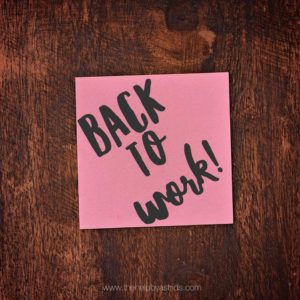
What makes an organized person? You may argue that a lot of things help a person get organized. But no one can do it without lists. List don’t have to be written to be effective. Some people can make do with mental list. They just commit the list of things they need to get done to memory for ticking off later. Yes. Some are blessed like that. Most of us would probably forget half the things we’ve mentally noted down. Especially when you’re older or if the mental list were made in the middle of the night, before dozing off after a long tiring day. We’re all guilty of doing that. However, the most efficient lists are the lists we write down where they are not in danger of being forgotten or where they can be referred back to from time to time. Written lists are way better. After all, even perfect Santa made lists…and checked them twice.
Here’s a breakdown of the perfect list and it has only 2 ingredients:
Choose a tool. A lot of us do it the old school way of using pen and paper for keeping lists. Grocery lists are often written on paper. So are lists of things to bring for travel or trips. You can also write lists on boards where you can easily see the list as a constant reminder. But if you are one of the more techie ones, which is often the case in today’s generation, you might opt to use any of the list making apps available on Android and iOS. Desktop apps are also available for those who spend more time in front of their computers.
Here are a few suggestions for apps:
- Google Keep: for Google Apps fans
- Todoist: for those who are fans of integration and connecting their apps with other tools.
- Remember the Milk: for sharing and delegating.
- Wunderlist: for fans of elegant, simple, and beautiful design.
- Any.do: for those who are minimalists.
Choose a system. Does your list begin with most important things first? That would work well for to-do lists. Do you want to go alphabetical? This works well for titles. Do you want to list items according to location? This works well for after work or weekend errands. In which case, you would do well to list the furthest first and the nearest last so you can work your way through errands on the way home.
Now, put them together and stick to the plan. One of the best feelings in the world is getting to cross off items on a list. Making lists will never be out of date. We all have thousands of things to do and all of them seemingly need our immediate attention. Being able to capture the thoughts buzzing around inside our heads into an organized list is half the battle. This actually lets us know what action items are needed and how we can plan our time around actually completing tasks. Do you have any favorite list making techniques you want to share with us? Let us know in the comments! Remember to stay humble and hustle hard.
Written by Jaie O.- The Help
 How many times have you been too tired or too lazy to prepare your meal that you just toss a boxed meal into the microwave or just made the wrong decision of getting take out fast food? Sure, you know you haven’t made a healthy choice, but they’re convenient and very easy. And you have zero time to make a home cooked meal right now.
How many times have you been too tired or too lazy to prepare your meal that you just toss a boxed meal into the microwave or just made the wrong decision of getting take out fast food? Sure, you know you haven’t made a healthy choice, but they’re convenient and very easy. And you have zero time to make a home cooked meal right now. January is the time for beginnings. This is the time when we vow to transition to healthier lifestyles, start new projects, build better goals, create new memories, and try to start new healthy habits. Back in November of last year, we started a series called “
January is the time for beginnings. This is the time when we vow to transition to healthier lifestyles, start new projects, build better goals, create new memories, and try to start new healthy habits. Back in November of last year, we started a series called “ I’m pretty sure we all have vacation hangovers from the chocolate and pie fueled holidays. And the past few weeks would have started off slowly and uneventfully. Everyone has pretty much been answering emails from that one person who kept sending updates during the holidays. (And if you are that person, you probably started the year getting replies from all the emails you sent out over the holidays.)
I’m pretty sure we all have vacation hangovers from the chocolate and pie fueled holidays. And the past few weeks would have started off slowly and uneventfully. Everyone has pretty much been answering emails from that one person who kept sending updates during the holidays. (And if you are that person, you probably started the year getting replies from all the emails you sent out over the holidays.) Are you done making your list of New Year’s resolutions yet? Have you vowed NOT to have any resolutions for the coming year?
Are you done making your list of New Year’s resolutions yet? Have you vowed NOT to have any resolutions for the coming year?